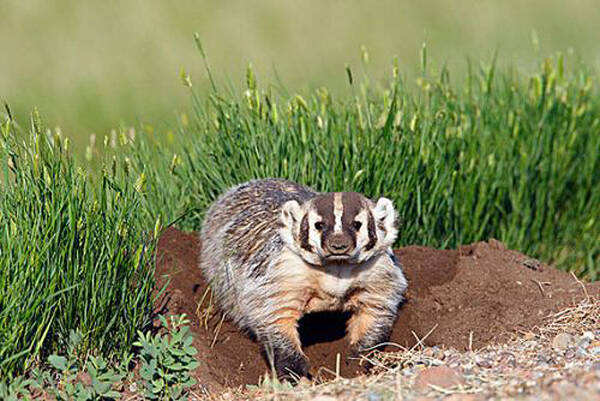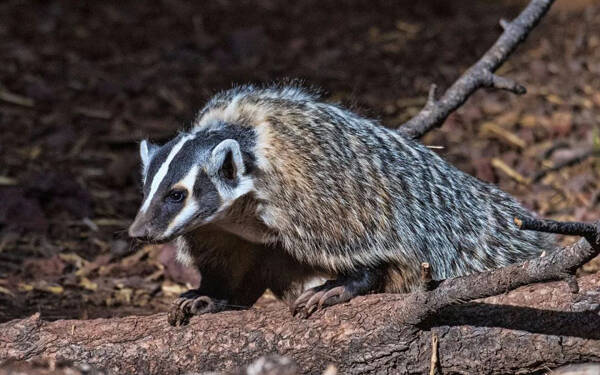Taxidea taxus
IUCN
LCBasic Information
Scientific classification
- name:Taxidea taxus
- Scientific Name:Taxidea taxus,American Badger,Badger
- Outline:Carnivora
- Family:A.badger
Vital signs
- length:52-72cm
- Weight:3.2-12kg
- lifetime:12-14 years, up to 26 years
Feature
Gray or red body color, white throat, black patches on face
Distribution and Habitat
Distributed in most parts of Canada, the United States, and Mexico, it is one of the more common animals in North America.
It lives in open grasslands, cultivated land, and savannas. It mainly lives in grassland environments and rarely enters forest areas. Sometimes it enters farmland areas. Its territory area is about 1.6-5 square kilometers.
Appearance
The American badger is 52-72 cm long, with a tail length of 10-16 cm and a weight of 3.2-12 kg. Males are slightly larger than females, with a fat body, short and thick limbs, a blue-gray body color, fine and long hair, white stripes on the face, and a middle stripe from the nose tip to the shoulder. The canine teeth on the upper jaw protrude from the lips, which looks ferocious. The ear shell and tail are short; the feet are wide, the front claws are long and the hind claws are short; the hair on the sides of the body is longer than that on the back and the back. The back is light gray; the snout, head and back of the neck are brown or almost black; there are narrow white stripes from the nose to the shoulder; the lower body is light yellow or yellow-brown white; the limbs are brown, and the feet are black.
The American badger has a wedge-shaped head, a flat body, a thick and short neck, strong shoulders, strong front legs, webbed toes and curved front claws, which are very suitabl
Details
American Badger (scientific name: Taxidea taxus) is also known as American Badger in English. It has 5 subspecies.

The American badger lives alone, is nocturnal, forages at dawn and dusk, has a semi-hibernating habit, and digs holes for home. Its nest can sometimes be up to 3 meters deep, and it builds a new home almost every few days, which are connected to each other. Over time, a complex network of tunnels has been formed underground.
American badgers can dig holes for prey, and a large proportion of their diet is voles, squirrels, groundhogs and other rodents. American badgers often follow the holes dug by these rodents and dig unswervingly until they catch their prey. When digging holes, they face down, hug their two hind legs, and dig the soil vigorously with their shovel-shaped front paws, causing dust to fly. Its outstanding digging skills are very beneficial to its survival. Because American badgers spend most of their lives in the caves they dig, during which time they mate and rest. If they encounter bad weather, they will block the underground tunnels from the inside of the den to avoid being attacked by heavy snowstorms. They will stay at home and sleep comfortably for several days. Even if they go out of the cave, if they encounter enemies, they can immediately take shelter in the cave. In the case of food shortage throughout the winter, they must dig rat nests to obtain food to survive. At this time, they rely entirely on their extraordinary digging skills.
Although the American badger is small in size, it is very ferocious. When it gets angry, it can kill hounds or coyotes that are two or three times larger than it. When fighting, it can expand its body hair to protect its body from harm as much as possible. When encountering powerful opponents such as bears or mountain lions, the American badger can use its strong limbs and sharp claws to dig holes to escape. When forced to do so, it will spray pungent urine like a skunk. It lives alone and only forms a couple during the mating season.
The American badger is an omnivorous animal, but it tends to be carnivorous and has a rich diet. Usually, the American badger goes out to forage at night, mainly preying on rats and insects, and is a beneficial animal. When zoologists observe them at night, they often see them walking slowly to find the nests of animals such as rats, while carefully sniffing and listening to the surrounding movements. If they find the larvae of bees, wasps and ants, they will immediately destroy their nests and lick them with their tongues. The American badger has a particularly sensitive sense of smell. It can smell whether there are rats in the underground caves on the ground, and then dig the ground to hunt them according to their scent.

American badgers are not suitable for aquatic life. They only catch crayfish, carp, bullfrogs and turtles in shallow streams. Once they encounter various nesting birds, bird eggs and chicks, they will swallow them whole. If they encounter lizards or snakes, they will remove the poisonous head of the prey before tasting it carefully. The American badger preys on many types of mammals, including hares, armadillos, porcupines, raccoons, foxes, young deer, young black bears, etc. Although the American badger likes to taste all kinds of fresh animals, it sometimes feeds on carrion like eagles and vultures.
Although the American badger looks very similar to the European badger, it is completely different from the European badger in temperament. It has almost no social life, and both male and female adult badgers are willing to live alone. Usually, each adult American badger occupies a territory of more than 8,000 square meters, and occasionally there are overlapping territories. Except for the midsummer when the male badgers go out to find mates, they rarely see each other. Once they meet unexpectedly, it often leads to a hostile scene.
The mating process of the American badger is extremely simple. The male and female mates go their separate ways after a quick finish. Although mating takes place in the summer, the fertilized eggs in the female badger's uterus do not begin to develop until the winter of the following year. This phenomenon is called "delayed implantation" in zoology. American badgers mate and reproduce in August and September each year, with one male mates with multiple females. Females do not conceive until December to February of the following year. The gestation period is about 6 weeks, and they give birth in April and May. Each litter has 1 to 5 pups, and the lactation period is 2 to 3 months. After several weeks of lactation, the young badgers begin to eat the solid food brought back to the den by the female badger. In late spring, they are accompanied by the female badger to go out to look for prey. In mid-June, the young badgers voluntarily or are forced to leave their mothers to find their own territory. Females reach sexual maturity at 6 months old, and males at 1 and a half years old. They can live 12 to 14 years in the wild, with a maximum lifespan of 26 years.
The American badger is an animal that brings mixed feelings to people. On the one hand, it plays an irreplaceable role in controlling grassland rodent pests, but on the other hand, its habit of digging holes to build nests and forage for food makes grasslands and farmlands bumpy and dangerous. Many cattle and sheep accidentally fall into traps and break their limbs, so farmers don’t like them and often poison or steal their guns. In addition, although their rough fur is not of good quality, it can at least be used to make brushes, so every year there are always some unlucky people who die in hunting activities. However, despite the decline in numbers, the American badger has expanded the distribution range of its own population with its super adaptability and high reproduction rate, and there is no danger of extinction.
Listed in the 2016 Red List of Endangered Species of the World Conservation Union (IUCN) ver 3.1-Least Concern (LC).
Protect wild animals and stop eating game.
Maintaining ecological balance is everyone's responsibility!








